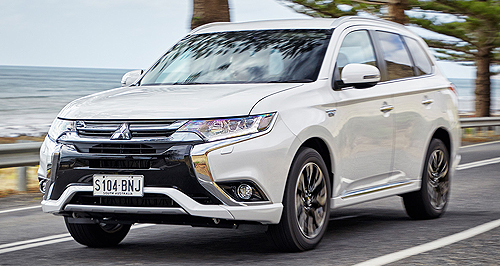News - MitsubishiMitsubishi’s first Nissan Alliance car due 2020-21Up in the air: Future versions of Mitsubishi’s Triton could share their underpinnings with the next Nissan Navara, but there is a chance they could use separate platforms. Supersized R&D budgets target production of better Mitsubishis10 Jun 2017 MITSUBISHI Motor Corporation will deliver its first shared vehicle as a new Renault-Nissan Alliance partner by 2020 or 2021, the company’s global chief operating officer Trevor Mann has announced, but the model and body style of the vehicle will remain a secret until later this year. The former Nissan performance officer – credited for ruthless cost-saving measures by the industry – partially revealed his plan to not merely develop greater efficiencies for Mitsubishi, but also to increase its research and development (R&D) budget in order to produce better vehicles. “What we’ve done since the (Renault-Nissan) Alliance started is we’ve really gone into low-hanging fruit,” Mr Mann, who joined the company in November 2016, told Australian journalists this week at an event in Sydney. “How we can get into competitive costs, how we can lever the scale volume to get lower cost parts and we’ve done things like transportation, the easy ones. In Australia we announced last week the (Mitsubishi) parts warehouse and sales/finance (would merge with Nissan) and things like that. “(But) to the contrary, the investment that we are making now from an R&D point of view from this year is much higher than it’s been in the recent past. I thought that was a weakness when I came to the company – if you look over the past few years, we’ve been really investing about 3.5-4.0 per cent of our revenue in R&D. The industry average is around 5.0 per cent. “Apart from sharing (with Nissan) some level of technology, platforms and powertrains, the amount of money that we’ll spend internally will increase … to get (Mitsubishi) cars closer to class-leading than before.” Although Nissan Motor Company Australia and Mitsubishi Motors Australia Limited (MMAL) announced a sharing of parts and accessories warehousing, and financial services commitments, Mr Mann said the company’s local headquarters and brand identity would remain as separated as future models themselves. Mr Mann acknowledged that long product lifecycles were a problem for Mitsubishi globally, with the current-generation Lancer small car notching up 10 years on sale this year, but he promised others would shorten going forward. At the same time as increasing the Mitsubishi R&D budget, Mr Mann explained that with the Renault-Nissan Alliance the extra expenditure could go even further than what the 1.0-to-1.5 increase on previous estimates could deliver alone. “In theory, this 5.0 per cent (R&D budget, as a percentage of revenue) can give us bang-for-buck in terms of the new platform development going into the future because we’ll be able to share the cost of the platforms with Renault and Nissan,” he said. “It does a number of things it means that we can afford to spend more money developing a car, but we can afford to better manage the lifecycle of the car in terms of minor changes, updating technology (and) it should lead to shorter cycles between generational changes. “This should allow us to have a better lifecycle management of our products, including the models that are around today.” Mr Mann used the example of the Mitsubishi Outlander medium SUV, which he said sells about 150,000 units globally per year, joining with the Nissan X-Trail platform, a current rival that comparatively sells 600,000 units. “(And) so the amortisation of their (Nissan) investment, purely in their platform, is four or five times quicker than it is for us,” he continued. “If we are allowed to share the cost of developing the platform, then we will get some benefit in terms of dollars that we have to develop for our next generation, we should be able to depreciate that investment quicker over the lifecycle.” Asked when the first Mitsubishi model could be expected to arrive as a fruit of the Renault-Nissan Alliance, Mr Mann replied: “I think it’s going to be 2021. “If you look at what is going to be the new (Renault-Nissan) Alliance platform, including Mitsubishi, it’s going to 2020-2021 when we come to replace the generation of vehicles that are currently offered,” he added. “So you can imagine what that might be.” In addition to Outlander joining with X-Trail, and the Mitsubishi Triton ute sharing with Nissan Navara, a decision is yet to be made whether Mitsubishi will continue in the small passenger-car segment with Lancer (see separate story). A mid-term plan, which will be revealed in October, will map out Mitsubishi’s future product strategy. However, Mr Mann already listed a duo of clear targets that the company will pursue. “We aim to get back to an operating margin of 6.0 percent, which is what we were in 2014-2015 areas,” Mr Mann said. “What we also want to do is grow our volumes – for the past few years we’ve hovered around the one million units globally, and we’re challenging for a 25 percent increase to around 1.25 million units. “That’s going to be the essence of the plan, if you like, the expected results. What I’ll explain in October is what are the nuts and bolts of that and how we want to achieve that end result.” Mitsubishi Motors Corporation will further aim to hit both targets “by 2019” – even before the first Renault-Nissan Alliance-based vehicle is due.  Read more21st of October 2016  Nissan acquires large stake in Mitsubishi MotorsMitsubishi to join Renault-Nissan alliance after 34 per cent stake purchase16th of May 2016  Mitsubishi deal will save billionsGhosn says new grouping will make 10 million vehicles, but volume not the main aim |
Click to shareMitsubishi articlesResearch Mitsubishi Motor industry news |
















Facebook Twitter Instagram